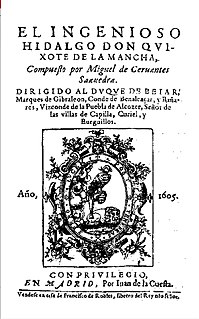
Don Quixote is a Spanish epic novel by Miguel de Cervantes. Originally published in two parts, in 1605 and 1615, its full title is The Ingenious Gentleman Don Quixote of La Mancha or, in Spanish, El ingenioso hidalgodon Quijote de la Mancha.
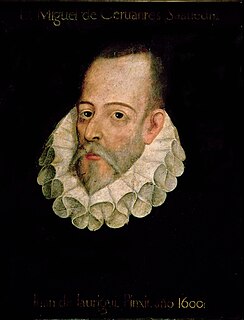
Miguel de Cervantes Saavedra was an Early Modern Spanish writer widely regarded as one of the greatest writers in the Spanish language and one of the world's pre-eminent novelists. He is best known for his novel Don Quixote, a work often cited as both the first modern novel and one of the pinnacles of world literature.

Sancho Panza is a fictional character in the novel Don Quixote written by Spanish author Don Miguel de Cervantes Saavedra in 1605. Sancho acts as squire to Don Quixote and provides comments throughout the novel, known as sanchismos, that are a combination of broad humour, ironic Spanish proverbs, and earthy wit. "Panza" in Spanish means "belly".

José Ignacio Javier Oriol Encarnación de Espronceda y Delgado was a Romantic Spanish poet, one of the most representative authors of the 19th century. He was influenced by Eugenio de Ochoa, Federico Madrazo, Alfred Tennyson, Richard Chenevix Trench and Diego de Alvear.
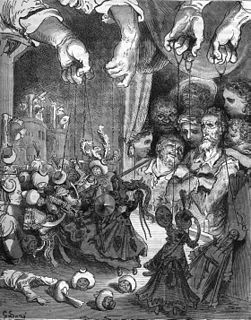
El retablo de maese Pedro is a puppet-opera in one act with a prologue and epilogue, composed by Manuel de Falla to a Spanish libretto based on an episode from Don Quixote by Miguel de Cervantes. The libretto is an abbreviation of chapter 26 of the second part of Don Quixote, with some lines added from other parts of the work. Falla composed this opera "in devoted homage to the glory of Miguel de Cervantes" and dedicated it to the Princess de Polignac, who commissioned the work. Because of its brief length by operatic standards, its very challenging part for a boy opera performer, and its use of puppets, it is not part of the standard operatic repertoire.

Cide Hamete Benengeli is a fictional Arab Muslim historian created by Miguel de Cervantes in his novel Don Quixote, who Cervantes says is the true author of most of the work. This is a skillful metafictional literary pirouette that seems to give more credibility to the text, making the reader believe that Don Quixote was a real person and the story is decades old. However, it is obvious to the reader that such a thing is impossible, and that the pretense of Cide Hamete's work is meant as a joke.

Ricote is a fictional character who is referred to in Miguel de Cervantes' novel Don Quixote. He was a wealthy Morisco shopkeeper and old friend of Sancho Panza, who was banned from Spain in 1609 like all Moriscos. The expulsion of the Moriscos was a highly topical issue at the time when Don Quixote was written - occurring in between the publication of the first part (1605) and the second one (1615).
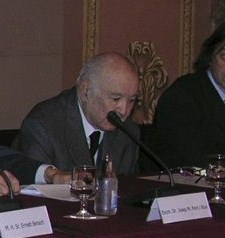
Martí de Riquer i Morera, 8th Count of Casa Dávalos was a Spanish–Catalan literary historian and Romance philologist, a recognised international authority in the field. His writing career lasted from 1934 to 2004. He was also a nobleman and Grandee of Spain.
Frederick A. de Armas is a literary scholar, critic and novelist who is Robert O. Anderson Distinguished Service Professor in Humanities at the University of Chicago.

Hispanism is the study of the literature and culture of the Spanish-speaking world, principally that of Spain and Hispanic America. It can also entail studying Spanish language and culture in the United States and in other presently or formerly Spanish-speaking countries in Africa, Asia, and the Pacific, such as the Philippines and Equatorial Guinea.

Lagunas de Ruidera Natural Park is a natural park in Spain, containing 15 small lagoons, the Lagunas de Ruidera, that are located in the La Mancha plain. The park's area is covers roughly 38 square kilometres (15 sq mi), reaching into the municipalities of Argamasilla de Alba, Ruidera, Alhambra, Ossa de Montiel and Villahermosa.
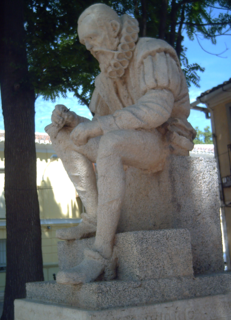
Cayetano Hilario Abellán was a Spanish self-taught sculptor who produced sculptures based on different themes. His work is known because of his group of characters from the Miguel de Cervantes' well known novel Don Quixote, among others.
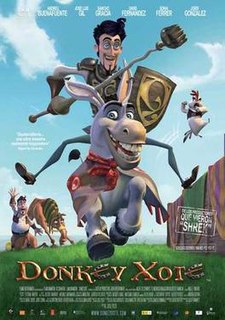
Donkey Xote is a 2007 3D computer-animated children's film produced by Lumiq Studios. A co-production between Spain and Italy, the film is directed by José Pozo and written by Angel Pariente, based on the Miguel de Cervantes novel Don Quixote, and features the voices of Andreu Buenafuente, David Fernández, Sonia Ferrer and José Luis Gil. The film is a mockbuster as the lead character Rucio bears an intentional resemblance to Donkey from the Shrek film series.
Don Quijote cabalga de nuevo is a 1973 Spanish-Mexican comedy film directed by Roberto Gavaldón, loosely based on Miguel de Cervantes's novel Don Quixote and starring Cantinflas as Sancho Panza, Fernando Fernán Gómez as Don Quixote, and María Fernanda D'Ocón as Dulcinea.

Juan de la Cuesta (?-1627) was a Spanish printer known for printing the first editions of Don Quixote de la Mancha (1605) and the Novelas ejemplares (1613), by Miguel de Cervantes, as well as the works of other leading figures of Spain's Golden Age, such as Lope de Vega.

Diego Martínez Torrón is a professor of Spanish Literature at the University of Córdoba, Spain, and a writer, author of essays, poetry and novels. He has been a speaker at many of the major universities in Europe and the United States. A specialist in nineteenth and twentieth century Spanish literature he has published numerous books on Spanish Romanticism, with interpretive contributions and unpublished texts. He has edited the most faithful edition of the complete works of authors such as José de Espronceda and the Duque de Rivas. He has also written about Lista and Quintana and the work of Spanish progressive liberals from the early nineteenth century to the end of the period of Romanticism. He has studied the poetic thought of Juan Ramón, Octavio Paz and José Bergamin. He has also dedicated numerous studies to the works of Cervantes. He has studied the narrative of Álvaro Cunqueiro, Juan Benet, Azorín and has published the first annotated edition of El Ruedo Ibérico of Valle-Inclán. His concept of literary methodology stems from a new, non-Marxist approach to the binomial ideology and literature. He has edited Don Quixote, studying the thinking of Cervantes.

Francisco de Robles was a bookseller in Madrid, whose shop was near the Puerta de Guadalajara. He was also a publisher; among his books are the first editions of Don Quixote (1605) and the Exemplary Novels (1613), by Miguel de Cervantes. Robles contracted with the printer Juan de la Cuesta to print Don Quijote in his shop at Atocha 87, in Madrid, which is today a museum and cultural center, and home of the Sociedad Cervantina.
Don Quixote, Knight Errant is a 2002 Spanish adventure film directed and written by Manuel Gutiérrez Aragón, consisting of an adaptation of the second part of Miguel de Cervantes' Don Quixote. It stars Juan Luis Galiardo and Carlos Iglesias respectively as Don Quixote and Sancho Panza, alongside Santiago Ramos, Fernando Guillén Cuervo, Manuel Manquiña, Kiti Manver, Manuel Alexandre, Juan Diego Botto and Emma Suárez.




















